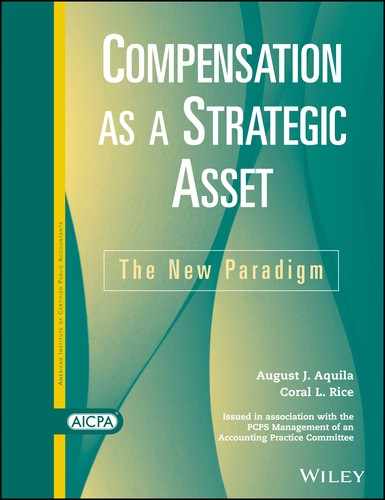BIBLIOGRAPHY
Andersen, Michael. Partner Compensation Systems in Professional Services Firms, Part I. http://www.edge.ai/Edge-International-1057905.html; accessed on January 25, 2007.
______. Partner Compensation systems in Professional Services Firms, Part II. http://www.edge.ai/Edge-International-1057907.html; accessed on January 25, 2007.
Aquila, August J., and Marcus, Bruce W. Client at the Core: Marketing and Managing Today’s Professional Services Firm. Hoboken, N.J.: John Wiley & Sons, 2004.
Aquila, August J. “The Marketing Plan: An Audit-Based Approach,” The Marketing Advantage: How to Get and Keep the Clients You Want. New York: AICPA, 1994.
______. “Splitting the Pie.” Partner to Partner Advisory (April 1999): 5.
______. “New Thoughts on Partner Compensation.” Accounting Today (June 5-18, 2006).
Ansoff, H. Igor. “Strategies for Diversification.” Harvard Business Review (September/October 1957), pp. 113-124.
Baker, Ronald, and Dunn, Paul. The Firm of the Future. Hoboken, N.J.: John Wiley & Sons, 2003.
Barker, Joel Arthur. Paradigms: The Business of Discovering the Future. New York: Harper Business, 1993.
Brotherton, Phaedra, and Hayes, Michael. “Meyners Mines Its Talent.” Journal of Accountancy (September 2002), pp. 47-50.
Brotherton, Phaedra. “Meyners Pays for Performance.” Journal of Accountancy (July 2003), p. 41.
Buckingham, Marcus, and Curt Coffman. First, Break All the Rules: What the World’s Greatest Managers Do Differently. New York: Simon & Schuster, 1999.
Chingos, Peter T. Paying for Performance: A Guide to Compensation Management. 2d ed. Hoboken, N.J.: John Wiley and Sons, 2002.
Collins, Jim. Good to Great: Why Some Companies Make The Leap . . . and Others Don’t. New York: Harper Collins Publishers, Inc., 2001.
Cotterman, James D. “Making Better Compensation Decisions,” Report to Legal Management, Altman Weil Inc., April 2006.
Covey, Stephen R. Principle Centered Leadership. New York: Fireside Press, 1992.
______. The 7 Habits of Highly Effective People. New York: Fireside Press, 1989.
______. The 8th Habit: From Effectiveness to Greatness. New York: Free Press, 2004
Drucker, Peter. The Drucker Foundation Self-Assessment Tool (Participant Workbook). San Francisco: Jossey-Bass, 1999.
Fajt, Marissa. “Firms Focus on College Grads to Fill Accountant Shortage.” Austin Business Journal (March 17, 2006).
Feeley, Tom. “What Do Managing Partners Do?” Partner Advantage Advisory 2, no. 10 (2004): 8.
Hamel, Gary, and C. K. Prahalad. Competing for the Future. Boston: Harvard Business School, 1994.
Hayes, Michael. “Pay for Performance.” Journal of Accountancy (June 2002).
Hays, Scott. “Pros and Cons of Pay for Performance.” Workforce Online (February 1999).
Heskett, James L., Jones, Thomas O., Loveman, Gary W., Sasser, W. Earl, and Schlesinger, Leonard A. “Putting the Service-Profit Chain to Work.” Harvard Business Review (March-April 1994).
Heskett, James L., Sasser, W. Earl Jr., and Schlesinger, Leonard A. The Service Profit Chain. New York: The Free Press, 1997.
Jorgensen, Karen. Pay for Results: A Practical Guide to Effective Employee Compensation. Santa Monica, Calif.: Merritt Publishing, 1966.
Kaplan, Herbert M. “Marketing Fundamentals: Terms and Concepts,” The Marketing Advantage: How to Get and Keep the Clients You Want. New York: AICPA, 1994.
Kaplan, Robert S. and Norton, David P. Translating Strategy into Action: The Balanced Scorecard. Boston: Harvard Business School Press, 1996.
______. Strategy Maps: Converting Intangible Assets into Tangible Outcome. Boston: Harvard Business School Press, 2004.
Kohn, Alfie. Punished by Rewards: The Trouble with Gold Stars, Incentive Plans, A’s, Praise, and other Bribes. New York: Houghton Mifflin Co., 1999.
Lagace, Martha. “Pay-for-Performance Doesn’t Always Pay Off,” HBS Working Knowledge, April 14, 2003.
Lencioni, Patrick. Overcoming the FIVE Dysfunctions of a TEAM: a Leadership Fable. San Francisco: Jossey-Bass. 2005.
MacKay, Karen. “Selecting the Compensation Committee: The Power of Balancing Personalities,” Edge International Review. Winter 2005.
Maister, David. Practice What You Preach. New York: The Free Press, Simon & Schuster, 2001.
______. “Stop Paying for Performance” Passion, People and Principles— www.davidmaister.com/blog, April 2006.
Marcus, Bruce W. Competing for Clients. Chicago: Probus Publishing Company, 1981.
______. Competing for Clients in the 90s: A Dynamic Guide to Marketing, Promoting & Building a Professional Services Practice. Chicago: Probus Publishing Company, 1992.
______. The Marcus Letter on Professional Services Marketing. www.marcusletter.com.
Mastracchio, Nicholas J., Jr. Mergers and Acquisitions of CPA Firms: A Guide to Practice Valuation. New York: American Institute of Certified Public Accountants, 1998.
Mayer, Steve. “What Do Managing Partners Do?” Partner Advantage Advisory 2, no. 6 (2004): 7.
Morgan, David K. “What Managing Partners Do: Committed to Leading the Way,” Partner Advantage Advisory 2, no. 9 (2004): 1, 6.
Niven, Paul R. Balanced Scorecard Step-by-Step: Maximizing Performance and Maintaining Results, New Jersey: John Wiley & Son, 2002.
Pfeffer, Jeffrey. “Six Dangerous Myths about Pay.” Harvard Business Review (May-June 1998): 109-119.
Prescott, Blane R. “Follow the Money—The Evolution of Partner Compensation Systems in Law Firms” (December 21, 1999), Hildebrandt International http://www.hildebrandt.com/Documents.aspx?Doc_ID=912.
Rice, Coral L. “What’s More Important: What People Undertake or What People Accomplish,” AICPA PCPS Firm Practice Center, 2005.
Rose, Joel A, “Newer trends in determining the most appropriate partner compensation system for your firm and standards to assess partner performance.” (http://www.joelarose.com/articles/newer_trends_partner_compensation.html.
Rosenberg, Marc L. “Not All Partners Are Created Equal: Essential Elements of an Effective Partner Compensation System.” Insight (May 1977): 9.
Ruiz, Gina, “Lessons From the Front Lines.” Workforce Management (June 26, 2006): 50-52.
Shechtman, Morri, “Five Steps to Becoming a Stronger Leader: A Challenge for 2004.” Partner Advantage Advisory, 2004.
Schuster, Jay R., and Zingheim, Patricia K. The New Pay: Linking Employee and Organizational Performance. San Francisco, Jossey-Bass Publishers, 1992.
Sewell, Carl. Customers for Life: How to Turn that One-Time Buyer into Customers for Life. New York, Currency by Doubleday, 1990.
Stern, Gary. The Drucker Foundation Self-Assessment Tool (Process Guide). San Francisco: Jossey-Bass, 1999.
Stimpson, Jeff, “The New Compensation Models.” Practical Accountant (December 6, 2004).
Sujansky, Joanne G. “The Seven Mistakes Leaders Make.” Partner Advantage Advisory, March 2004.
Telberg, Rick. “Boomers, X-ers and Y’s: CPA Generation Gap is Real,” www.CPA2Biz.com, February 2005.
“The Flaster/Greenberg Difference,” http://www.flastergreenberg.com/careers/flasterdifference.cfm; 2006, Flaster/Greenberg.
Waterman, Robert, Peters, Thomas, and Phillips, Julien. “Structure is Not Organization.” Business Horizons, June 1980, Volume 23, Issues 3. pp. 14-26.
